Playing Card Decks with Five or
More Suits
a resource guide compiled and written by Michael Keller
Michael Dummett states in The Game of Tarot that five-suited decks date
from the fifteenth century -- nearly as old as the four-suited deck.
Five-suited bridge, using a five-suited deck of 65 cards, was invented in 1937 by
Dr. Walter Marseille of Vienna (see The Official Encyclopedia of Bridge).
The fifth suit was blue or green, ranked between spades and no trump,
and was called by various names in
different countries. It was a popular game for a year or
so. (In 1938, Parker Brothers published its own version called
Five Suit Castle Bridge, crediting Ammiel F. Decker with inventing it in 1933). A good
historical summary of five-suited games is given by David Pritchard in
his On the Cards column in the June 1975
Games & Puzzles.
A few of the decks were reviewed many years ago in WGR. Photos are scans of
cards in my own collection. Some of the websites cited include
pictures of other decks. Many of the decks described here
are no longer in production, and many are hard to find even used.
Most of the names of games and decks are trademarks of their respective
manufacturers.
Solitaire Virtuoso
The omnibus solitaire program we are
developing has support for up to eight suits, in four colors: Stars and
Circles are blue, and Bells and Hourglasses are green (the artwork at present is somewhat primitive). This
works well with many games; single-deck games with play in suit (Aces Up, Fortress, Montana) or where suits are irrelevant (Pyramid) can be expanded slightly or to the equivalent of a double-deck game. Six-suited games allow a kind of 1-1/2-deck
game with three colors, which works well with alternate-color packing
games like Klondike and Demon (Canfield). These can also be
played as somewhat easier double-deck games by using eight suits, since
cards can be packed more freely (as in Thumb & Pouch, each card can
be packed on 3/4 of the suits).
Conventional Decks with Five Full Suits
Jack-Poker -- inventor uncredited, published by Jack-Poker Ltd., 1981,
$8.95 for two decks and rulebook (extra decks $3.95 each) [Reviewed in WGR8, July 1988]
Over five hundred years later comes an American
re-invention of the five-suited deck, this time for poker, gin rummy,
and blackjack (it is absurd to use a five-suited deck to play
blackjack, where suits are irrelevant). What could have possessed
the inventors to name their
fifth suit clovers? A fifth suit should have a name and symbol
different from
any of the other four; clovers is too close to clubs in name and
symbol. Nowhere is the ranking of poker hands discussed;
the odds
of each type of hand change somewhat; flushes become harder to obtain
and should rank above full houses. And if you're going to play with
five suits, a
special hand containing one card of each suit should be included. This
combination historically goes by various names: flash, prime, primero, or rainbow. I suggest that a prime should
not be allowed to contain
any pair; this produces the ranking and frequencies shown in the table
below. Allowing pairs in primes makes them more common than three
of a kind. This is a good game for dealer's choice poker; the
primes add variety. The publishers managed to get two of their games
approved for play in casinos. The rule booklet contains rules for
thirty variations of poker and other card
games.
Cinco-Loco Poker Playing Cards
These were produced by USA Playing Card Company (not the U.S. Playing
Card Company); the fifth suit is a design using all four suit symbols
plus a yellow pentagon. They are mentioned in several surveys,
and were still in print around 2000, but the only picture I could find
was on a private auction site.
Don't Quote Me Sport Quotes Playing Cards
Produced by Wiggles 3D Incorporated, and currently available for $9.99,
these are pentagonal playing cards with a fifth suit of Quotes (black
single quotation marks). All of the cards have
quotations from famous sports figures.
Five Star
Five Star Playing Cards produced a five-suited deck in 1991,
manufactured by Gemaco. The fifth suit is stars, printed in
gold.
Wild Playing Cards
Five-suited deck created by a Canadian company,
who hoped to introduce it in casinos for poker. The fifth suit,
called Wild, uses a design with all four conventional suits (they are
not wild in the poker sense). Apparently unavailable now.
Dragon Playing Cards
Three different designs for a five-suited deck; the fifth suit is stars.
The Star Deck
The Star Deck is a five-suited deck with a fifth suit of five-pointed stars (black and red). They appear not to be currently in production.
Zark City
Looneylabs produces a five-suited deck of 65 cards, in five colors, especially for its game Zark City.
These cards are square (to allow the building of gameboard-like
structures), and are in five colors, with an extra suit of yellow stars. Available at $10.
Deck of Shields
This is a recent five-suited deck with a blue suit of shields
added. The webpage includes a brief but excellent
historical survey with photographs of many decks. Available
at $14.95.
Five Shortened or Expanded Suits
Yankee Notion Cards
In his classic book A Gamut of Games,
Sid Sackson gives a description of a deck, developed around 1856 by Thomas W. Strong
(and named after his magazine Yankee Notions), as an
alternative for those who felt regular playing cards were immoral ("the
Devil's Picture-books"). The deck consists of 50 cards in
five suits (Faces, Flags, Eagles, Stars, and Shields; the Faces suit
depicts ten fictitious characters). Sackson includes rules
for one of the 16 games, Hekaton. What is apparently the full set
of games using this deck is included in a Hoyle from 1857 by Thomas
Frere; the 1875 edition is available online
at
archive.org. These cards are apparently extremely rare; a search
online did not even turn up a picture of a single card (but plenty of
baseball-themed decks). There was also a Yankee's Notion brand of
playing cards made by the Union Playing Card Company, but these were
first made during the American Civil War and are standard playing cards.
Plaza
A card game put out by Parker Brothers in 1913, using five colored
suits (marked with animals as suit symbols) of 10 cards
each. Plaza is an adaptation of a game called Sevens (also known as Dominoes, Fan Tan, or Parliament).
Estate Playing Cards
Designed by Keith Wilson and produced in Australia by the Vasey Corporation, this is a five-suited deck in five colors,
with 12 ranks per suit, plus two extra cards (Pope and President) for a
total of 62. There is no jack; queen and king are replaced by
Woman and Man. Clubs are blue, Diamonds are orange, and the new
suit of Waves (two ovals side by side) are green. The rules folder includes adaptations of seven games.
It does not seem to be available at present. Vasey also
produced a five-suited deck of 60 cards, Elements, based on the Chinese Zodiac.
5th Dimension Playing Cards
This is an 80-card deck with five suits in five colors; each suit includes a Princess (ranking between Jack and Queen) and a Joker. Currently unavailable.
Modern Commercial Games
Five-suited decks are becoming more frequent in German games, although often as
part of a board game. The games mentioned below are specifically
card games.
Five Crowns
A rummy variation developed in 1996 by Set Enterprises (now part of PlayMonster), Five Crowns
uses two identical decks of 58 cards. Each deck contains five
suits running from 3 to king (no A's or 2's), plus three jokers. Still in production.
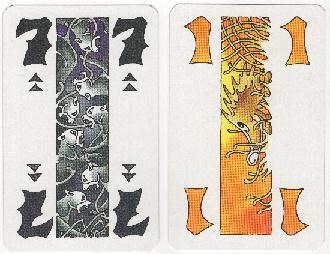
Mü & Mehr
Invented by Frank Nestel, this is one of the most original card games ever,
a complex tricktaking game with many unusual features, playable by 3-6
players (but best with five). The 60-card deck, with artwork by
Doris Matthäus, includes five suits of 12 cards each (0-9, with
duplicate 1's and 7's), with some cards marked with 1 or 2 triangles
showing their point value in tricks. Also includes rules
for four other games (five in the original edition) played with the
same deck. Still in production in various editions.
Rage
A variation of Oh Hell! using a 108-card deck with cards numbered 0-15
in six colors, plus 12 action cards of six kinds; no suit symbols. In production from Ideal (originally made by International Games, famous for the crazy eights variant Uno).
Sticheln
My edition of this (1993, Amigo Spiele) has cards 0-14 in six colors; apparently some earlier editions had 0-18 in each color.
Tripoley Wild
Cadaco extended its long-running Tripoley game with the addition of a
fifth suit. [Tripoley is described inaccurately as a combination
of Michigan Rummy, Hearts, and Poker. It is actually an
adaptation of Michigan (also known as Newmarket, Stops, or Boodle) and
is not a rummy game at all. Players collect chips for
high-ranking hearts they hold, but this has nothing to do with the game
of hearts].
Trumpet -- published by International Games, 1990, $10 [Reviewed in WGR12, January 1994; no longer in production]
Trumpet, a tricktaking game, combines a playing board with a six-suited
69-card deck (11 cards in each suit, plus three extra cards called
trumpets which act as 'super trumps'). The playing board serves two
purposes -- a scoreboard as in cribbage (each trick won advances the
player's token to the next vacant space), and to allow changes in trump
suit -- a player landing on a Choose Trump space selects a new suit to
be the highest ranking suit. Players receive seven cards each to start;
another round begins when all these cards have been played. Play is as
in most tricktaking games -- the player who plays the highest ranking
card wins the trick, advances her token, and leads to the next trick.
At the start there are no trumps, and only cards of the suit led can
win tricks. Gradually all suits will be declared trump, and the six
suits will be arranged in some order (which may change from trick to
trick) which determines a complete ranking of the cards, from trumpets
to the one of the lowest suit (this is my interpretation -- the rules
are not completely clear on this point). The player reaching the Home
space first wins.
Though this may be an entertaining family game, it seems too chaotic to
appeal to the serious card player. The small amount of skill involved
is washed out by an enormous luck factor. The main problem is that
long-range planning is almost impossible: With at most seven cards
held, and six suits, someone will be void on virtually every trick.
Being on lead is almost never advantageous (even leading a trumpet is
no sure thing, as the last trumpet played to a trick wins the trick).
Usual techniques such as drawing trumps and running long suits will not
work, as everything is trump!
Six-suited Decks
International Playing Cards -- designed by Hiram Jones, published by the International Playing Card Company, 1895
This appears to be the oldest six-suited deck, with two extra suits:
crosses (red), and bullets (black; just round circles). The World Web Playing Card Museum has a page on this deck, including images of some of the cards and a leaflet of rules published in 1896.
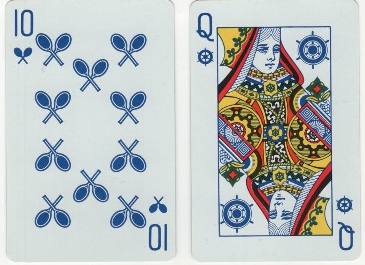
Sextet -- invented by Ralph and Peggy Peterson, published by Secobra,
1964, 1986, $10 for Sextet Bridge, $6 for Texas Poker (plus postage) [Reviewed in WGR12, January 1994]
Sextet is a 6-suited, 78-card deck with two new blue suits
called wheels and rackets (representing travel and leisure
respectively). Sextet was originally designed for a six-handed bridge
game (played in two 3-player partnerships) -- ideal for a bridge party
where there are an odd number of couples. Rules have also been
developed for a number of games, including 6-card poker (there are
almost 100 times as many six-card hands using a six-suited deck as
there are five-card hands with a four-suit deck), canasta, gin rummy,
and several forms of solitaire. Demon (Canfield) is actually a
better game with six tableau columns and six suits in three colors.
There is a lot of scope for improving various card solitaires by
changing the parameters of various games, and one rich area of
investigation is the use of larger decks. For example, the game Aces Up -- extremely difficult to win -- can be improved by
using the six-suited Sextet deck and dealing six cards instead of
four. Boxed double-deck bridge sets are available (with an
18-page rulebook) for $10 plus postage; single decks in a vinyl case
(with a leaflet of rules to one of the other games) are available for
$6 plus postage; a packet of rules for all games is $1. Highly
recommended for card-playing enthusiasts and game inventors. My brother
and I have used Sextet to play our two-handed version of Super Crazy
Eights. I also used a deck to build a set for playing Matt Crispis' ingenious six-suited card game,
Octagon, which combines features of rummy and mancala, published in
Games & Puzzles (December 1975).
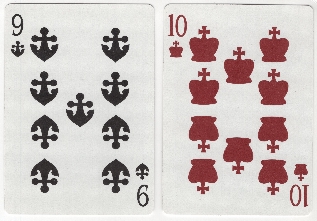
Empire Deck
Produced in 1990 by a Canadian manufacturer but no longer in
production, the two-color Empire deck used two additional suits of
black anchors and red crowns ("hooks and hats"). Alternate-color
solitaires like Klondike and FreeCell have a more conventional feel
with a two-color deck than with a three-color deck.
Game Crafters (The Blue Sea Deck, Decktet, the Proxy Suits Deck, and more)
P.D. Magnus has designed a number of six-suited decks, all currently available from his print-on-demand company The Game Crafter. The Blue Sea Deck is a six-suited deck in three colors;
the two extra suits, in blue, are stars and squids. The
Proxy Suits Deck is a six-suited deck with 0-15 in six colors; the suit symbols are actual suits ("all the suits from ape to zoot"). Decktet is a six-suited deck of 45 cards, but with most cards (2
through 9) having two different suits.
The Game Crafter also sells decks by other designers, including Jim Watson's Deck6 (part of SHP Games),
which includes black shields and red cups with pip designs intended to
blend with the existing black and red suits. SHP also has a
five-suited variant of hearts called Crown Hearts. K6T, by Jean-Louis Cazaux and his company pionissimo,
is a six-suited, six-color deck with extra suits of purple stars and
blue moons. The standard deck is 120 cards, with each suit
including 0-12 and extra court cards using chess symbols; this can be
expanded all the way up to the K6T-Infinity deck of 234 cards
(including ranks 0-24!).
Eight-suited Decks
Tujeon and Hanafuda
Tujeon is a
traditional deck of long, narrow cards used in Korea during the 17th
through 19th centuries. A full deck contained eight suits of ten
cards each (1-9 plus a General), with symbols representing people and
various animals. They lost popularity after the introduction of
Japanese Hanafuda cards, which can be seen as having 12 suits (though with only four cards each) representing the months of the year.
Cripple Mr. Onion and the Fatpack Deck
In several of his Discworld
novels, Terry Pratchett describes a card game played by the inhabitants
of Ankh-Morpork. Cripple Mr. Onion, which first appeared in Witches Abroad,
is a hybrid of poker and blackjack, played with
an eight-suited deck. Dr. Andrew C. Millard and Prof. Terry Tao
developed a full set of rules, and with Pratchett's approval, posted it
online; the full rules
can be found on the Discworld Wiki. The game is best played
with two decks, one with French/English suit symbols (spades, hearts.
clubs, diamonds), and the other with Italian/Spanish suits (staves,
swords, cups, and coins); in a pinch, two standard decks will
do. A commercial eight-suited deck, Fatpack Cards,
is available from a company in the U.K.; their additional four suits
are Roses, Axes, Tridents, and Doves. This is a two-color deck:
Roses and Doves are red, while Axes and Tridents are black.
8 Suits
Another eight-suited deck, but apparently unavailable now.
Toss Double Deluxe Decks
Hollywood Poker
A version of Struggling Upstream published in 1994 with eight suits (colors) of 13 numbered cards.
Nine-suited Decks
The 9-Suit Extended Deck
by Tau Games consists of nine suits of 17 cards each (with four added
face cards per suit). There is an extra black suit, Cups,
an extra red suit, Shields, and three new blue suits, Crowns, Bottles,
and Anchors. So it would be possible, for example, to play
a six-suited version of Klondike or FreeCell, for example, with either two suits each in three colors, or
three suits each in two colors, or a full nine-suited solitaire with three colors.
Ten-Suited Decks
Arboretum
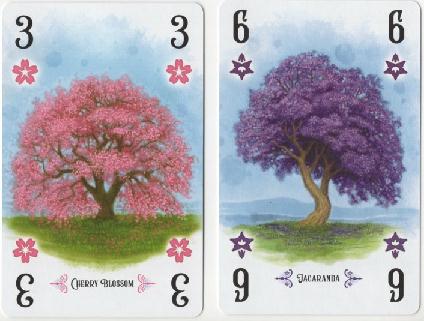
Arboretum -- 2018, Renegade Games, $20
Arboretum, by Dan Cassar, is a card game using a ten-suited deck (80
cards, 1-8 in each suit) depicting ten species of trees. There is scope for developing new games using the deck, or adapting it for existing games. This is perhaps the most attractive set of playing cards I own.
The Rainbow Twelve-color Deck
This is a new deck, designed by Chen Changcai,
with six suits in two colors each (essentially a double six-suited deck
with each deck having a different color scheme: hearts are red and
pink, spades black and grey, etc.). Six jokers are added, for a total
of 156 cards. The numbered cards are also separately sequentially numbered on one
corner from 0-119, and the cards also have letters, dominoes, and other
symbols, enabling their use for a wide variety of games.
Available at $23.99.
Combinations of Cards and Dominoes
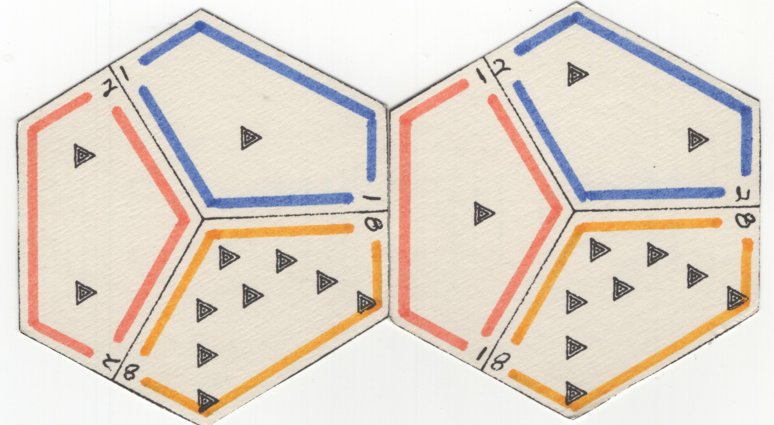
Trios -- invented by Alan Hench, published by Trios, 1987, $5 [Reviewed in WGR8, July 1988]
Subtitled "Playing cards for the next thousand years",
Trios are a cross between playing cards and dominoes. Each card is a
hexagon divided into three sections. 45 of the 50 cards have sections
in three different colors (red, yellow, and blue), each section having
a different number
of spots (1 to 9). There are also five wild cards. The rule booklet
contains rules for nine games, including
a domino-like game and two solitaire games. Several games are loose
adaptations
of well-known card games such as bridge and poker. A table of odds for
one
of the games, Tetra (a Poker adaptation), is included. Inventors
will enjoy tinkering with new games for this deck, modestly priced and
highly recommended to card playing
enthusiasts and collectors of gaming
curiosities. [Now long out of
print; I cannot find any information on the Internet anywhere, even on
BoardGameGeek or eBay.]
Poker probabilities
Five Card Poker Hands with Five-Suited Deck
1 Five of a Kind 13
2 Straight Flush 50
3 Straight Prime 1200
4 Four of a Kind 3900
5 Flush 6385
6 Full House 15600
7 Straight 30000
8 Prime (Flash) 153240
9 Three of a Kind 214500
10 Two Pairs 429000
11 One Pair 3575000
12 No Pair 3831000
Total Hands 8259888
Bibliography
Board Game Geek -- Estate Playing Cards, 5th Dimension Playing Cards
Crispis, Matt -- Octagon, Games & Puzzles 43, December 1975, pages 14-15
Deck of Shields -- Five Suit Decks
Deckipedia -- Suit (cards)
Dummett, Michael, and Sylvia Mann -- The Game of Tarot, 1980, Duckworth, 600pp., hardback, ISBN 0-7156-1014-7
Dworkin, Paul -- A Five Suited Deck of Cards, 2002, Gathering For Gardner Five, 3 pages
Short survey including some rules variants for poker, spades,
hearts, and solitaire. Part of the G4G5 gift exchange, which
included a deck from Five Star Games.
Francis, Henry G., editor-in-chief -- The Official Encyclopedia of
Bridge, 922 pages, hardback, 1984, Crown, ISBN 0-517-55272-8, $24.95
Frere, Thomas -- Hoyle's Games, 1857, 1875, [Boston] DeWolfe, Fiske, and Company, 365pp.
Yankee Notion Cards are described on pages 140-179, with rules for 16 games.
Neill, Phil R. -- The History of the Joker Card, online
Pritchard, David -- "F" is for Fifth Suit, On the Cards, Games & Puzzles 37, June 1975, pages 42-43
Sackson, Sid -- A Gamut of Games, 1969, Random House, 210pp.
Yankee Notion Cards, with the rules for Hekaton, are given on pages 26-29.
Wikipedia -- Playing Card Suit
Most recently edited on May 28, 2024.
This article is copyright
©2024 by Michael Keller. All rights reserved.





